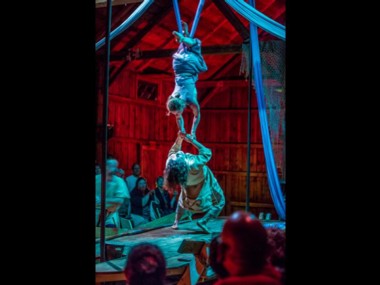In the curtain speech before a performance of his production of A Midsummer Night’s Dream at Smith College a few weeks ago, director Daniel Kramer said he considered us, the audience, “part of the cast”—an integral component of the production, the piece that brings a performance to life and whose expected presence forms part of the creation process. As he explained, “You just didn’t show up until tonight.”
Often that involvement is more than metaphorical. Hearing Kramer’s speech, I started thinking about shows I’ve seen over the past year that made me feel I was part of the proceedings and not just a passive onlooker. The list includes shows whose presentation ranged from direct address to the audience to active involvement, to pieces in which the spectators actually represented characters in the play.
The latter approach is a common device in one-person plays: we, the audience, are imagined guests of the protagonist, who welcomes us into his or her world. This was the convention, for instance, in three one-woman plays last summer in the Berkshires. In two separate performances, Tod Randolph received imagined visitors in novelist Edith Wharton’s stately drawing room and journalist Dorothy Thompson’s cluttered study, and Debra Jo Rupp recapped “Dr. Ruth’s” eventful life for us while packing up her Manhattan apartment.
Then there’s the more rambunctious school of audience involvement, typified by Shakespeare & Company’s performances in their outdoor tent theater (it was Molière’s Tartuffe this year) with much running up and down the aisles and close-up interactions with spectators. Double Edge Theatre’s annual indoor-outdoor epics (most recently The Odyssey) take the audience along with them on participatory perambulations of their Ashfield farm. The Valley’s champion at casting the audience is, of course, PaintBox Theatre, whose twisted fairy tales press kids and grownups alike into service as onstage extras, sound-effect-makers and choral readers of projected stage directions.
Other productions this year drew the audience more subtly into their universe. Middletown, at Springfield College, a postmodern re-evaluation of the classic Our Town, made us feel like part of the town when, during the intermission, several of the actors became ticket-holders discussing their responses to the show. In the August Company’s intimate staging of Twelfth Night, the audience surrounded the action in plain sight of each other and touching distance of the performers.
For Turgenev’s claustrophobic drama A Month in the Country at Williamstown Theatre Festival, the actors sat watching the action from just outside the playing area, making themselves part of the audience and us part of the family of onlookers. Front-row cameras in The Curious Case of the Dog in the Nighttime, beamed by satellite from London’s National Theatre, made us feel as if both we and the cast were right there in the auditorium with the live audience. And in the Northampton Center for the Arts’ recent theater-in-the-round production of the original Our Town, performers chatted with attendees beforehand and watched each others’ scenes from a side of the stage that completed the circle of audience.
For me, shows that frankly acknowledge the audience’s presence are what theater is all about. It’s more than a spectator sport. We are involved, whether actively or at arm’s length, breathing the same air, tingling with the same reverberations, co-celebrants in the age-old ritual of common heartbeat.•
Contact Chris Rohmann at StageStruck@crocker.com.



